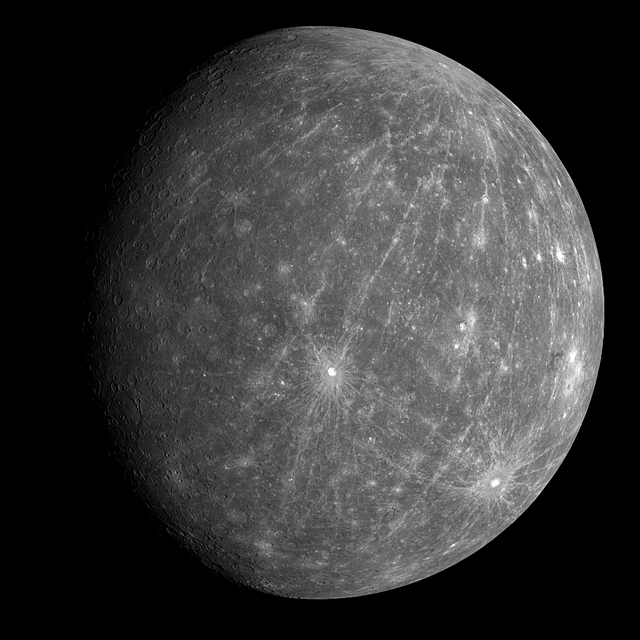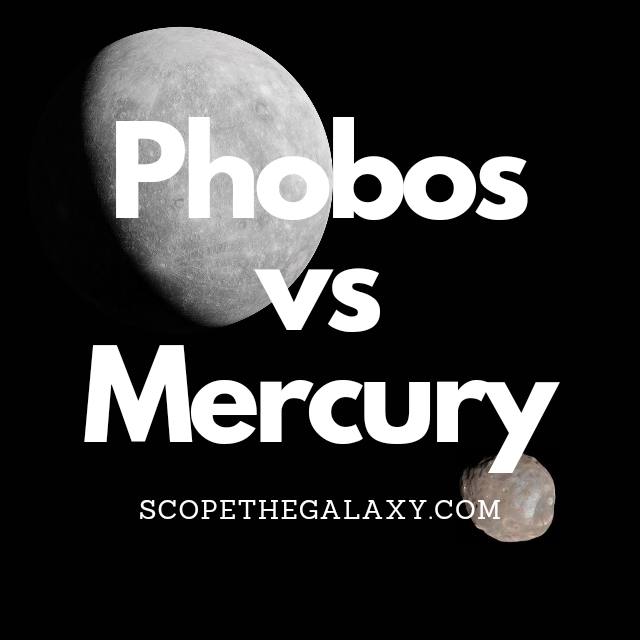*This post may contain affiliate links. This means we may make a commission if you purchase an item using one of our links*
The main differences between Phobos and Mercury are that Phobos is a natural satellite that orbits Mars while Mercury is a planet that only orbits the Sun, Phobos is far smaller with a diameter of 22.53km compared to Mercury’s 4,879km and Phobos is getting closer to Mars roughly 1.8cm every year, where it may potentially collide with Mars while Mercury is not likely to do the same with the Sun.
For a more detailed look at each entity along with their similarities, continue reading as it will be covered more thorughly in the sections below.
What Is The Moon Phobos?
Table of Contents

Phobos is the larger and innermost of the Martian moons, named after the Greek God of fear and panic. This rocky satellite measures approximately 27 x 22 x 18 kilometers and possesses an irregular shape.
Flying only 270 km above Mars’s surface, Phobos orbits the Martian surface so closely that it spins around the planet three times a day (each orbit takes 7 hours and 39 minutes). And this proximity means that the moon cannot always be seen from Mars’ surface (it all depends on where you’re standing).
In general, Phobos rises in the west, passes through the sky in around 4 hours, and sets in the east. And this process occurs twice during one Martian day.
Phobos travels 1.8 m closer to Mars every 100 years, which means this doomed moon will one day crash into its planet or break up into rings. Still, this won’t happen for another 50 million years or so.
The moon is covered in streak patterns from impact craters, the most significant of which is the crater Stickney, with a diameter of 9.7 km. Phobos has weathered thousands of meteorite impacts, one of which almost shattered it to pieces.
It was first discovered by the American astronomer Asaph Hall on 17th August 1877. But, it can be difficult for astronomers to see as it is one of the least reflective bodies in the solar system with an albedo of 0.071.
Despite its small stature, Phobos experiences wildly varying temperatures on its dark side compared to the light side. Measurements on the light side of the moon suggest that temperatures can rise to -4 degrees Celsius, a sort of brisk winter’s day that would be cold but tolerable.
In contrast, temperatures on the dark side can drop to -112 degrees Celsius, even though the two areas are just a few kilometers apart. The probable cause is fine surface dust that cannot retain heat, allowing temperatures to drop rapidly.
The low density of Phobos suggests its composition is similar to carbonaceous chondrite meteorites, which could mean that Phobos is a captured asteroid.
What Is The Planet Mercury?

Mercury is the planet closest to our Sun and would fall under the terrestrial planet moniker. Out of the 8 main line planets Mercury is also the smallest, coming in at 4,879km.
This planet is known for having its fair share of craters, which is mostly down to its thinner non protective atmosphere that is unable to stop interstellar debris from striking its surface.
Despite its close proximity to the Sun, Mercury is not the hottest planet in our solar system but, it does come in second, just behind Venus. It’s surface temperature is around 430 degrees on the upper end with the average temperature around 167 degrees Celsius whereas its core is far hotter at around 1,600 – 3,000 degrees Celsius.
Due to it close proximity to our local star, Mercury is unable to sustain a moon around its orbit and even has a very unique rotation around the Sun where it has 3:2 orbital resonance with the Sun.
As for how long it takes for the planet to rotate around our yellow dwarf star, its the shortest time period of 88 days for obvious reasons, whilst a single day on the planet takes 58.65 Earth days to complete. Its axial tilt is only 2 degrees to the right, making it amongst the straightest planets in the solar system too.
Similarities Between Phobos And Mercury
Phobos and Mercury do have their fair share of similarities, which in this case would include the following:
- Both have a hotter central core.
- Both are terrestrial planets.
- Both have a very thin atmosphere and a rocky surface.
- Both have no other natural satellites orbiting them.
- Neither have tectonic plates.
Differences Between Phobos And Mercury
As for the differences between the two, they include the below.
- Phobos orbits Mars whilst Mercury only orbits the Sun.
- Mercury is a spherical shape while Phobos is not.
- Mercury is a terrestrial planet whilst Phobos is a terrestrial based natural satellite.
- Mercury has a diameter of 4,879km whilst Phobos has a diameter of 22.53km.
- Phobos has no atmosphere whilst Mercury has a very thin atmosphere composed of oxygen, sodium and hydrogen.
- A day on Phobos takes 7 hours 39 minutes whilst a Mercury day takes 58.65 days.
- It takes Phobos 7 hours 39 minutes to orbit Mars and around the Sun in 687 days whilst Mercury orbits the Sun in 88 days.
- Mercury has an axial tilt of 2 degrees whilst Phobos’ axial tilt is closer to 0.
- Phobos’ temperature ranged between -4 to -112 degrees Celsius whilst Mercury has an average temperature of 167 degrees Celsius.
- Mercury’s density is 5.43 g/cm³ whilst Phobo’s density is 1.88 g/cm³.
- Mercury’s mass is 3.285 × 10^23 kg whilst Phobos’ mass is 10.6 × 10^15 kg.
- Phobos’ gravitational strength is 0.0057 m/s² whilst Mercury’s is 3.7 m/s².
- Phobos is tidally locked to Mars whilst Mercury is is not tidally locked to any entity but is in a 3:2 orbital resonance with the Sun.
- Mercury has a magnetosphere whilst Phobos does not.
- Phobos only orbits Mars 6,000km away and is getting closer to the planet by 1.8 meters every 100 years.
Summary
In conclusion Mercury and Phobos are clearly very different from one another, from their phyiscal shape to the fact one is a planet and the other a natural satellite.
Despite the fact Mercury and Phobos inhabit the same solar system and are both rock based celestial bodies, they are very easily disntiguishable just based on their shape alone.

